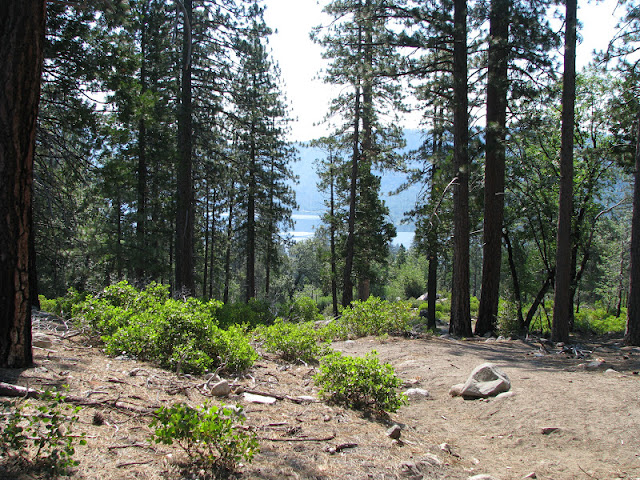Sadly, all that beautiful area I've written about below is now gone. Over 180,000 acres of forest, and the wildlife for which it was home are burnt to ashes. Goodness knows how long it will take for the area to recover.
I look at the photos from our trip there 6 years ago and cry.
Place: Cherry Lake, Stanislaus National Forest, California
Trailhead coordinates: 37.9830, -119.9041
Hike date: July 1, 2007
Difficulty level: easy to moderate.
After giving up on booking a camp site in Yosemite for the summer, we decided to go to Cherry Lake campground in Stanislaus National Forest, two miles west of the border of Yosemite National Park.
Cherry lake is accessible via a long and winding, narrow mountain road, connecting it to California road 120, west of Yosemite. We arrived there at noon on Saturday, settled in a nice camp site and spent the rest of that afternoon on the beach.
 |
| Cherry Lake in the morning - view from the dam. |
The trailhead to Lake Eleanor is on the dirt road that goes along the east shore of Cherry lake. We left the car there after hiding all of our extra food in the bear boxes, and headed east.
 |
| A lizard by the trail. |
Although just 4 years old at the time, the older chika walked admiringly well. I carried her little sister on my back and Papa Quail carried all of our water and food. We walked slowly.
Mid summer is an excellent time to see the bloom of the Sierra Nevada mountains. At that time I had an inferior camera, and most of my close up photos didn't come out right. Still, I managed to get some nice photos of some of the flowers we've seen.
 |
| A pink carpet |
 |
| Lupine |
 |
| Winecup clarkia |
 |
| Charming centauri |
 |
| Douglas' monardella |
After about a mile of hiking we got our first view of Lake Eleanor, down in the valley.
 |
| Lake Eleanor |

Lake Eleanor, like Cherry lake and the other lakes in that region, are all man-made and a part of the Hetch-Hetchy water system that leads drinking water to the residents of the San Francisco Bay.
The trail to lake Eleanor is only 2 miles long but it was a hot day, so when we got all the way down, we took advantage of our seclusion and went into the water for a refreshing swim.
 |
| Lake Eleanor, a view from next to the dam. |
 |
| Fish in lake Eleanor |
We did exit the water in some haste when we spotted a snake swimming right next to us. It didn't stick around for a photograph, though.
This pretty butterfly though, did stay put long enough:
 |
| California sister butterfly |
 |
| Allium |
 |
| Lake Eleanor |











































